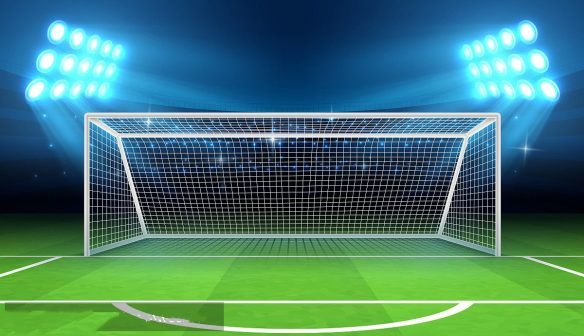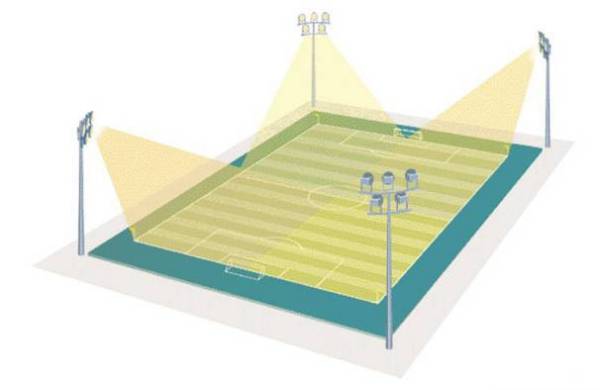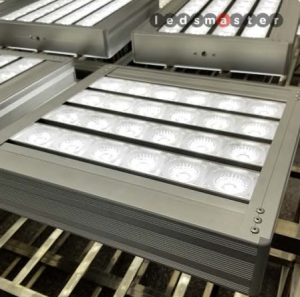Tachyon—the Best Solution for Stadium Illumination
Football Stadium Lighting Design Standard
- Light source selection
1.1 High-power LED stadium lights should be used in stadiums with a building height greater than 4 meters. Whether it is outdoor or indoor, high-power LED lights are sports lighting, and the most important light source for TV broadcast priority.
1.2 The choice of light source power is related to the number of lamps and light sources used, and it also affects the parameters such as illuminance uniformity and glare index in lighting quality. Therefore, selecting the light source power according to the site conditions can make the lighting scheme obtain a higher cost performance. The LED light source power is classified as follows: 1000W or more (excluding 1000W) is high power; 1000~400W is medium power; 250W or less is low power. The power of the light source should be suitable for the size, installation position and height of the playing field. Outdoor stadiums should use high-power and medium-power LED lights, and indoor stadiums should use medium-power lights.
1.3 The luminous efficiency of LED stadium lights of various powers is 90~200Lm/W, the color rendering index is 70~90Ra, and the color temperature is 3000~6500K according to the type and composition. For outdoor sports facilities, it is generally required to be 4000K or higher, especially at dusk to better match sunlight. For indoor sports facilities, 4500K or higher color temperature is usually required.
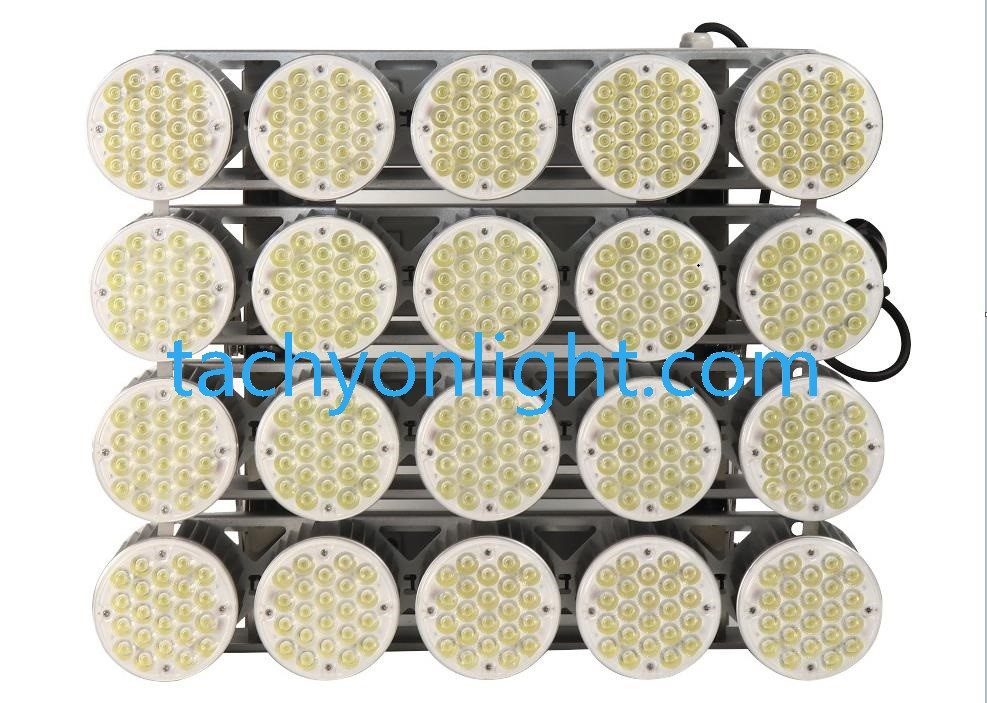
1.4 The lamp should have anti-glare measures.
1.5 Lamps used in gymnasiums with long service life, LED stadium lights have long service life, stable performance, and slow light source decay; high-power HPS lamps or metal halide lamps usually have a short service life, fast light decay, and are not suitable for long Time and frequent use.
1.6 The lamps and lanterns should not adopt the open design. The protection grade of the lamp housing should not be less than IP65, and the protection grade should not be less than IP67 in places that are not easy to maintain or heavily polluted.
- Light pole requirements
2.1 The four-tower or belt lighting method of the stadium, to select the high lighting pole as the bearing body of the lamp, can adopt the structural form combined with the building.
2.2 The high lighting pole should meet the following requirements:
When the height of the light pole is greater than 20 meters, the electric lifting basket should be used;
A ladder should be used when the height of the light pole is less than 20 meters. The ladder should have a guardrail and a rest platform.
2.3 High lighting poles should be equipped with obstacle lighting according to navigation requirements.
- Outdoor stadium
an Outdoor stadium lighting should adopt the following arrangement:
Arrangement on both sides-The lamps and lanterns or the construction horseway are combined and arranged on both sides of the competition field in the form of continuous light strips or clusters.
Four corners arrangement-The lamps and lanterns are combined in a concentrated form and arranged at the four corners of the playing field.
Mixed layout-a combination of two-sided layout and four-cornered layout.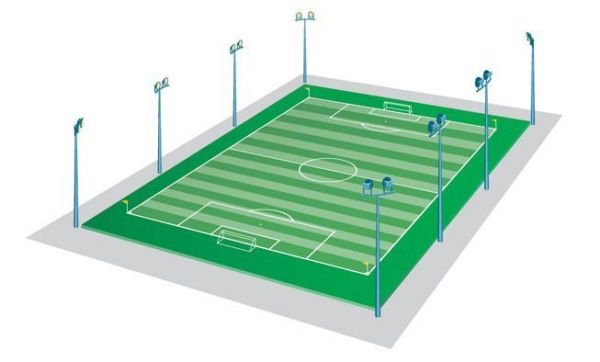
Lighting and Power Supply
A lighting system must be installed to meet the needs of broadcasters, viewers, athletes and officials, while not spilling light into the environment and causing no trouble to the local community.
Power Supply
Delays or cancellations of events due to grid interruptions are unacceptable. Careful evaluation of available utility services is essential, but redundant services and backup power and ride-through power are all required. Redundant mains electricity from utilities should be sized appropriately to carry the facility when an incident occurs.
The intake manifold can be in a preferred/standby arrangement (Figure 9a), or it can be used as a “heat” source in use (Figure 9b) to handle individual facility loads by manually or automatically tightening switches. After the intake power is lost, the on-site backup power should be started immediately, but there will be a certain time lag. Therefore, this backup must include
Because live lighting (usually high-intensity discharge (HID)) will go out and it will take a few minutes to restart, and live broadcast will be interrupted, there will be a certain crossing capability when the live light source is activated. This ride through can be provided in many ways, including a dedicated generator and
Uninterruptible power supply (UPS) system. The backup power supply should have at least three hours of operation during the power outage.
The load of the basic event must be distinguished and separated from the load of the life safety system, because the main requirement of the traversal event is a continuous event, not leaving the facility in an emergency. In order to allocate equipment space for intake and backup air sources, additional planning is required.
It is recommended to maintain separation and provide multiple distribution points with some overlap and redundancy.
Facility requirements
Overview
The main goal of the event lighting system is to illuminate the event into digital video quality media without causing annoying glare to the player/official, nor adding overflow/glare to the audience and surrounding environment. Consideration should be given to permanent lighting, temporary lighting, and a combination of both systems.
–surroundings
Both inside and outside the stadium, special attention should be paid to limit the scattered light and glare outside the field.
–Players and officials
Players and officials must be able to maximize their ability in a lighting environment that enhances the ability to play.
– Audience
Spectators must be able to watch the game comfortably, scoreboards, videos and all activities on the field without glare and excessive overflow light.
-Media
Media videos and broadcasts generated during the event should have digital quality, balanced lighting, and no hard shadows or glare.
Competition category
Five types of lighting systems (I to V) have been developed. There are two types of lighting that require TV quality, and three types are non-TV events.
| Class V | International televised
|
Event pitch shall be shadow free/glare free.
|
| Class IV | National televised
|
Event pitch shall be shadow free/glare free.
|
| Class III | National game non-televised |
Event pitch shall be glare free with a minimum
of eight poles (recommended) |
| Class II | Leagues and clubs non-televised | Event pitch shall be glare free with a minimum of six poles (recommended). |
| Class I | Training and recreation non-televised | Event pitch shall be glare free with a minimum of four poles (recommended). |
Installation height of lamps
The installation height of the luminaire is critical to the success of sports lighting systems. The installation height geometry of the sub-headstock and pole starts from the middle of the court and looks back at the stadium seat bowl at a 25-degree angle to the horizontal. The head frame and light structure may exceed this minimum guideline of 25 degrees, but not more than 45 degrees.
Camera angle to consider
There are many possible camera positions that can be used to create a TV experience. The camera positions shown are some commonly used positions.
The lighting specification should consider the actual camera position to be used to ensure that each camera receives enough light to create high-quality video. If necessary, other suggestions for proper television can be sought from broadcasters or regional television alliances.
The main goal of the lighting system is to ensure symmetrical lighting for contact line and target line conditions. Can add fixed camera and field camera without affecting digital video quality.
Player and broadcast perspective
Providing glare-free environments for players, officials and media is the most important design requirement. For all five categories of competition, the following two areas are defined as “no floodlight areas”:
– Corner area:
In order to maintain good visual conditions for goalkeepers and offensive players around the corner, lighting equipment must not be placed in a 15-degree area on both sides of the goal line.
– Behind the target line:
In order to maintain good visual conditions of the attacking object in front of the goal and the goalkeeper and the video media at the other end of the court, the lighting equipment shall not be placed within 20 degrees and 45 degrees behind the goal line from the goal line to above the horizon.
Shadow control (multi-zone aiming)
Limiting hard-line shadows on the court is becoming one of the biggest problems facing high-definition digital video quality media. Multi-zone aiming refers to repeated aiming from different headframe positions to similar positions on the court. This repeated aiming from different positions limits the hard shadows created by the player.
9f and 9g divide the pitch into three areas, area 1 represents the two end areas, and area 2 represents the middle area of the pitch. The sights in each area should have at least four overlapping lighting arrays on each side in international competitions, and at least three overlapping lighting arrays on each side in domestic television competitions.
When the event player is surrounded by lighting from different locations, modeling can be achieved to create a balanced lighting environment. When there is no hardline shadow on the court, a shadowless environment can be achieved.
Installation plan (non-television)
For international and national television broadcast events, the lighting headframe is located on the stadium for digital video quality lighting. Non-elevated pitching does not require multi-zone aiming. For national, league and training non-television events, the following standard lighting design guidelines apply.
Lighting design specifications and technology
Horizontal uniformity
Horizontal
Horizontal illuminance is a measure of light reaching a horizontal plane one meter above the game surface. A 10m x 10m grid across the sports ground is used as the basis for collecting these measurements and calculating the maximum/minimum/average illuminance on the sports ground.
Mutations
Football is a high-speed sport, and maintaining uniform lighting throughout the playing field will enhance player performance and create excellent high-definition video. The method of calculating uniformity is as follows. Two methods, CV or UG, can be used to calculate uniformity.
| Televised events | Non-televised events | |
| Co-efficient of variation (CV) | CV ≤ 0.13- 0.15 | CV ≤ 0.3 – 0.4 |
| Uniformity gradient (UG) | UG = 1.5-2 | UG = 2-2.5 |
Color temperature
Color temperature describes how a certain type of lighting looks warm (red) or cold (blue). The unit is Kelvin (Tk).
Current digital camera technology allows the media for video production to be changed to “get” color and contrast to produce the desired color quality. For all types of games, the acceptable color temperature of the outdoor stadium is Tk≥4,000.
Color rendering Index
Color rendering is the ability of artificial lighting sources to reproduce natural light. The color development practical grade is Ra20 to Ra100, the higher the grade, the better the color quality. For TV and non-TV events, the good color produced by the artificial lighting system should be Ra ≥ 65.
Summary of lighting specifications for TV events
The following table summarizes the criteria that should be considered for TV events. It provides recommendations for vertical and horizontal illuminance, uniformity, and color characteristics of lamps for each activity.
Lighting specifications for televised events
| Vertical illuminance | Horizontal illuminance | Properties of lamps | |||||||
| Ev cam ave | Uniformity | Eh ave | Uniformity | CCT | CRI | ||||
| Class | Calculation towards | Lux | U1 | U2 | Lux | U1 | U2 | Tk | Ra |
| Class V International | Fixed camera | 2400 | 0.5 | 0.7 | 3500 | 0.6 | 0.8 | >4000 | ≥65 |
| Field camera (at pitch level) |
1800 | 0.4 | 0.65 | ||||||
| Class IV National |
Fixed camera | 2000 | 0.5 | 0.65 | 2500 | 0.6 | 0.8 | >4000 | ≥65 |
| Field camera (at pitch level) |
1400 | 0.35 | 0.6 | ||||||

